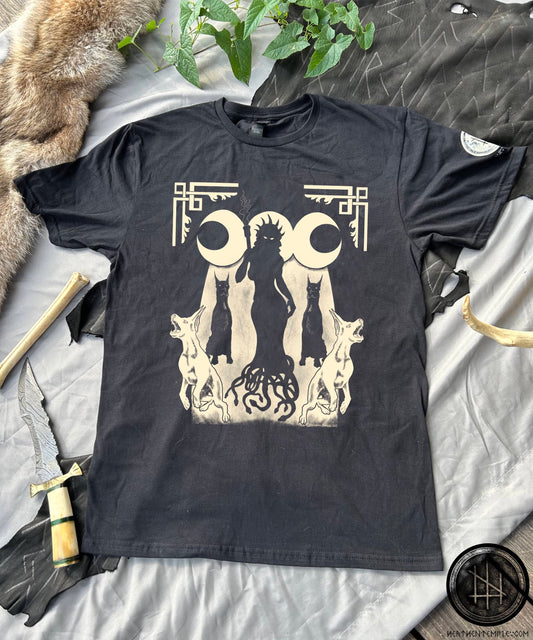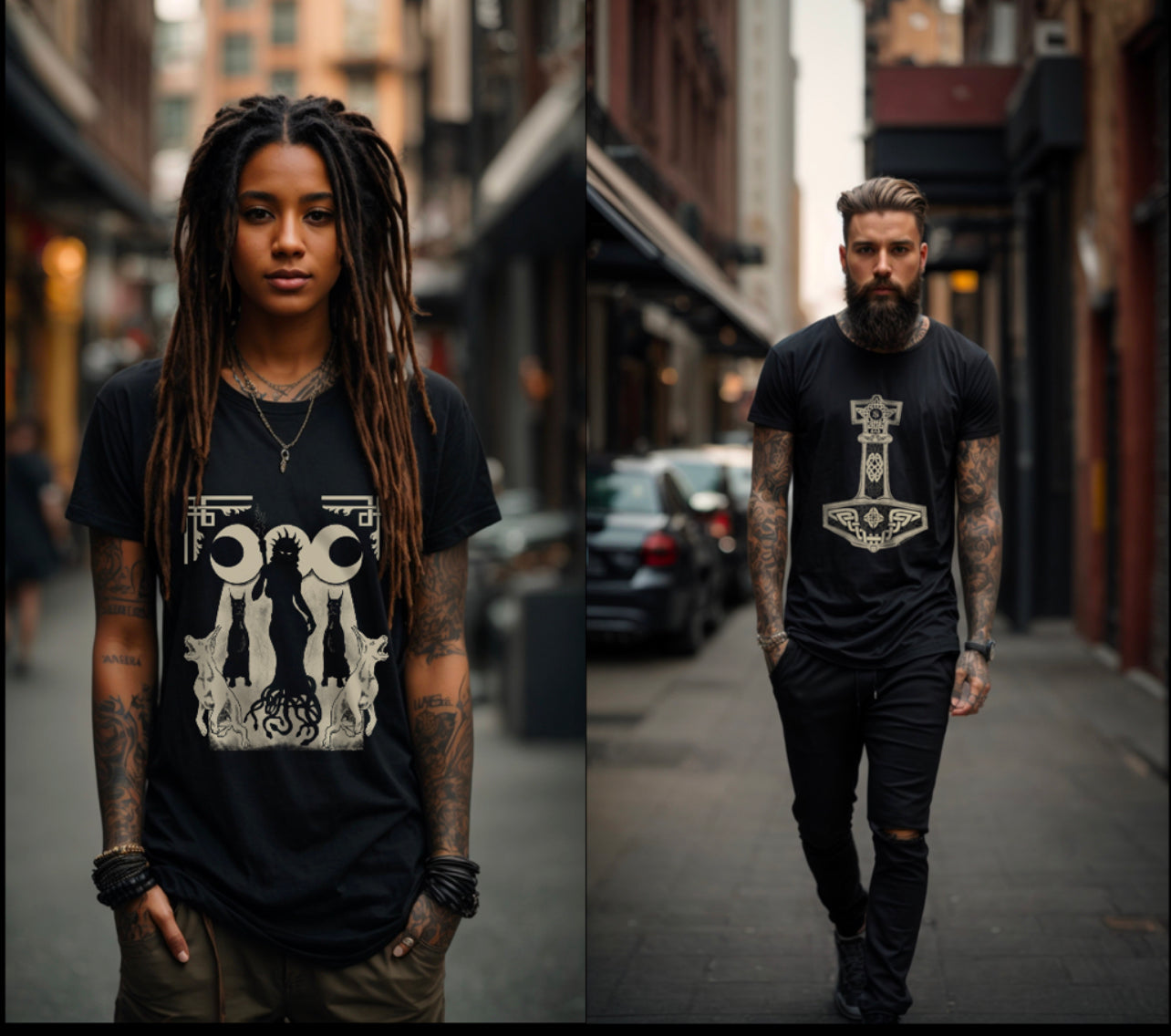The Correlation and Differences Between Hecate and The Morrigan: A Deep Dive into Divine Archetypes
What happens when two powerful deities, each embodying mystery, transformation, and sovereignty, are brought into the same conversation? Hecate, the ancient Greek goddess of magic, crossroads, and liminality, and The Morrigan, the Irish triple goddess of battle, sovereignty, and prophecy, are two figures that captivate the imagination of modern pagans and spiritual seekers. Both hold a commanding presence within their respective traditions, yet they share striking similarities that can blur the lines between their identities. Are they reflections of the same divine archetype, or do they serve vastly different purposes? Let’s explore the fascinating intersection and divergence of these two goddesses.
Hecate: The Torchbearer of Liminality
Hecate, often depicted holding torches or keys, is a goddess of thresholds—both physical and metaphysical. Originating in ancient Greek mythology, she is associated with crossroads, magic, and the unseen world. While her image evolved over time, Hecate has always been a guide through darkness, a protector of witches, and a figure of transformation.
In her role as a liminal goddess, she moves between realms: life and death, the physical and the spiritual. Her torches illuminate the path for souls in the underworld, and her keys unlock the mysteries of magic and self-discovery.
Key associations of Hecate include:
• Domains: Magic, witchcraft, night, necromancy, and crossroads.
• Symbols: Torches, keys, dogs, and the crescent moon.
• Roles: Psychopomp (guide of souls), protector of the home, and goddess of transitions.
Hecate’s modern worship often emphasizes her wisdom, her connection to the moon’s phases, and her role as a goddess of personal transformation.
The Morrigan: The Phantom Queen
In Irish mythology, The Morrigan stands as a figure of fierce power, prophecy, and sovereignty. Unlike Hecate, The Morrigan is a triple goddess, composed of three aspects—often identified as Badb (battle frenzy), Macha (sovereignty), and Nemain (chaos or frenzy)—or viewed as a singular entity with multiple manifestations.
The Morrigan is deeply tied to the land and its cycles of life and death. She appears at moments of great change, often in battle, to foretell outcomes or to influence events. Her connection to crows and ravens symbolizes death, war, and transformation, as these birds are both scavengers and symbols of the otherworld.
Key associations of The Morrigan include:
• Domains: War, prophecy, sovereignty, and the cycle of life and death.
• Symbols: Crows, ravens, horses, and the battlefield.
• Roles: Guardian of the land, bringer of prophecy, and guide in times of upheaval.
The Morrigan’s worship today often focuses on reclaiming personal power, embracing transformation, and understanding the cyclical nature of life.
Shared Themes Between Hecate and The Morrigan
The similarities between Hecate and The Morrigan are striking, particularly in their shared connection to transformation, liminality, and power. Both goddesses exist at the edges—whether it’s the threshold between life and death or the battlefield where sovereignty is claimed. Here are some notable overlaps:
1. Liminality and Thresholds
• Hecate rules the crossroads, symbolic of decisions and transitions.
• The Morrigan presides over moments of transformation, such as the chaos of battle or shifts in leadership and sovereignty.
Both goddesses embody the tension of change and the power that comes from navigating uncertainty.
2. Guidance in Darkness
• Hecate’s torches light the way through shadowy paths, including the underworld.
• The Morrigan, though often associated with death and war, provides clarity through her prophetic visions.
Each goddess offers guidance during times of fear and uncertainty, though their methods differ.
3. Symbols of Power and Mystery
• Both goddesses are associated with animals tied to death and the otherworld (Hecate with dogs and The Morrigan with crows/ravens).
• Their symbolism reflects their dominion over forces that are both feared and revered.
4. Archetypes of Female Sovereignty
• Hecate and The Morrigan represent autonomous, powerful female figures who are not subordinate to male counterparts.
• They challenge traditional notions of femininity, embodying strength, independence, and complexity.
Key Differences Between Hecate and The Morrigan
While the similarities are significant, the differences between these two goddesses highlight their unique cultural and spiritual roles:
1. Cultural Context
• Hecate is deeply rooted in Greek cosmology, tied to the Olympian and chthonic pantheons, and her worship is often centered around witchcraft and household protection.
• The Morrigan is a Celtic goddess, interwoven with the mythology of Ireland, and her domain extends to the land, sovereignty, and the cycles of war.
2. Focus and Purpose
• Hecate’s role is more aligned with magic, wisdom, and guiding transitions, particularly in the context of personal and spiritual growth.
• The Morrigan is primarily concerned with sovereignty, prophecy, and the fate of individuals and nations, often manifesting in moments of great upheaval.
3. Visual and Symbolic Representation
• Hecate is often shown with torches, keys, and lunar symbols, representing her connection to the unseen and the mysteries of life.
• The Morrigan is typically associated with crows, ravens, and the battlefield, emphasizing her role as a goddess of war and transformation.
4. Personal vs. Collective Power
• Hecate often works on an individual level, guiding personal transformation and magical practice.
• The Morrigan’s power extends to the collective, influencing battles, leadership, and the destiny of entire communities.
Are Hecate and The Morrigan Connected?
Though Hecate and The Morrigan emerge from distinct cultural and mythological backgrounds, they can be seen as reflections of similar archetypes—the powerful, liminal goddess who holds sway over transformation, sovereignty, and mystery.
For modern practitioners, these goddesses may resonate in complementary ways. Hecate might be invoked for personal guidance, protection, and spiritual exploration, while The Morrigan might be called upon for courage, sovereignty, and navigating collective struggles.
Conclusion: Two Goddesses, One Mystery
Hecate and The Morrigan stand as testaments to the enduring power of divine archetypes. They remind us that transformation, whether on the battlefield, at the crossroads, or within our own souls, is both inevitable and sacred. By honoring their unique strengths and shared themes, modern seekers can draw on their energies to navigate life’s challenges with wisdom, strength, and sovereignty.
Both goddesses ask us to confront the unknown with courage and to embrace the power that comes from standing at the edge of transformation. In doing so, they illuminate paths not just to survival but to profound growth and empowerment.



